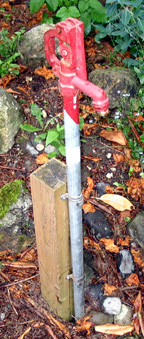A grass or yard hydrant is a frost free hydrant. They will not be a viable choice for your use. They will not drain the underground line as you want to. I've installed them for water treatment customers running water around a farm. You want loads of gravel for the drain and there has to be sufficient volume in the hole to accept all the drain water from numerous drainings. If not, freeze up off the bottom 2-3' of the hydrant can occur.
You need a totally under the frost level by 6-12" water system, except where it enters a cabin vertically, that is easily and quickly shut down and drained at one point.
You have to allow or introduce air into a pipe to get the water in it to flow out the far end; or your drain in this case. You can not have any 'bellies' in the lines because all the water will not drain out of the line back to the drain. When water freezes, the volume of ice is bigger than the liquid volume of the water being frozen. The freeze will be from the top down, and ice floats in/on water, plugging water lines with bellies before all the water freezes. The expansion then busts pipes. Well metal before plastic but the best plastic is PE pipe or PEX. They are forgiving of freeze ups; PVC and CPVC are not.
You need a large central dry well for the drain. I'd use like an empty 55 gal plastic barrel with 3/8" holes all over the top sides and bottom, about every 2". Not large enough holes to let gravel in. It would be buried so the top is 12-15" below the frost line (and the water line would be on top of it, running across the top of the barrel), with about 12" of gravel around and under the barrel. I would cover the top of it and the gravel surrounding it with tough plastic like overlapped by 2-3" softener salt bags and then with 3/4" marine grade plywood or pressure treated 2x6 or 8" with another layer of plastic over the wood and then back fill to grade over all of it.
The water line would have to run downhill to the top of the barrel at least 2" to insure adequate pitch from both cabins for the water to run out and not pool on top the barrel.
You'd also need some way to drain the line. I might go an inexpensive normally open 120v solenoid (we use a NC version for a UV light - $50-125 each). It would be on a tee in the dry well below the frost line on top of the barrel.
I'd pay for electric to keep it closed while we use the cabin(s) and when we turn off the electric or lose it from a power outage, the solenoid opens draining the pipe while the pressure bleeds off the water in the plumbing and pressure tank because the power to the pump was lost or shut off too (at the same time or by the same switch or circuit breaker). One probelm would be a loss of power in the middle of the night and no one opens a faucet to allow air into the plumbing, in both cabins. Another solenoid, a NC, at the highest point of the water line in each cabin, that opens when power is lost or shut off, would do that. They would be on a tee and their outlet could be plumbed with a vacuum breaker so in the event of an accidental power turned off situation, you wouldn't have water spraying all over the cabin... or simply power them off the same switch/circuit breaker the drain solenoid is power off. I'm just winging this right now ya know (I've added this above).
The power cable to the solenoid would be bury able well pump cable with waterproof heat shrink connections. I'd put the solenoid in a more or less sealed cover box with 5-6' ect of excess cable so when needed I can pull it up out of the ground to change a solenoid valve. And to do that, you might not want to bury everything permanently, just to keep it from freezing and accessible.



